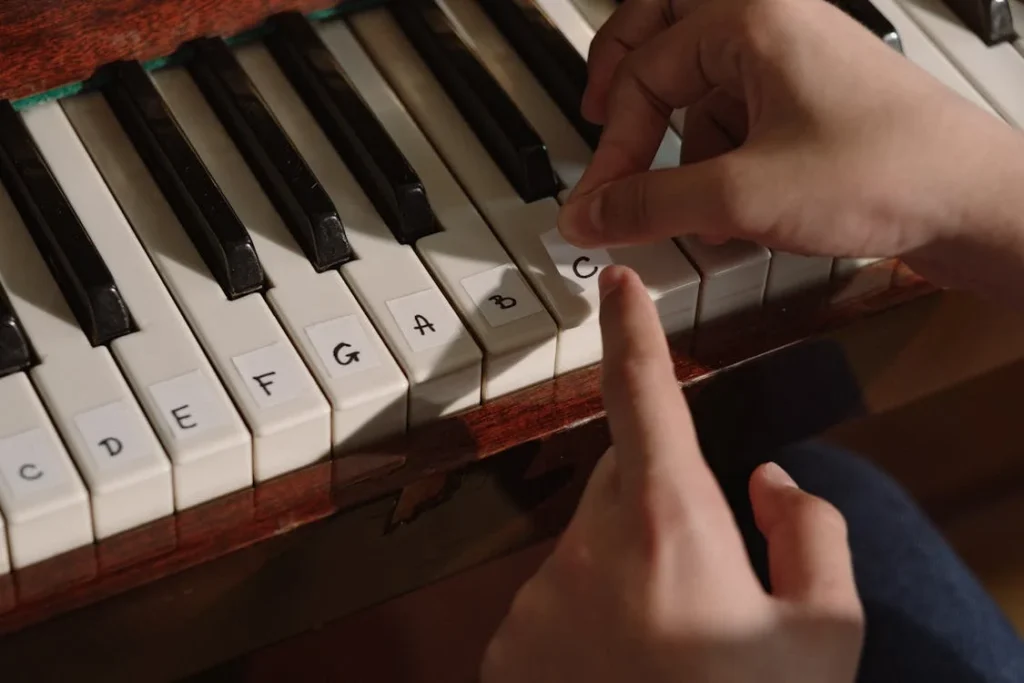When learning music theory it often seems like a maze of rules, but it can also be the key to unleashing your creativity. One such fascinating topic in music theory is parallel scales. By mastering these piano scales, you can seamlessly shift the mood of your music, add emotional depth and expand your musical palette.
In this guide, we’ll explore what parallel scales are, how they differ from other scales and how to use them in your playing. Whether you’re playing piano chords, improvising, or simply practicing, understanding parallel scales will open the door for many musical possibilities.
- Fall in love with the music - Learn your favorite songs, at a level suitable for you.
- Enjoy interactive piano lessons - Explore courses covering music theory, technique chords & more.
- Get real-time feedback - Skoove's feedback tells you what went well and what needs practice.

What are parallel scales?
Parallel scales are scales that share the same tonic note (key center) but have different structures. For example, C major scale and C minor scale are parallel because they both start on C, yet their notes and intervals differ significantly.
Comparing parallel scales and relative scales
Understanding the distinction between parallel scales and relative scales is crucial for grasping their unique roles in music theory. While both involve relationships between scales, they serve different musical purposes and are constructed differently.
Defining parallel scales
Parallel scales share the same tonic note but differ in their intervals and structure. For example:
- C major (C, D, E, F, G, A, B)
- C minor (C, D, E♭, F, G, A♭, B♭)
Both scales begin on C, but the minor version has three altered notes, the 3rd, 6th, and 7th making a natural minor scale, giving it a darker, more melancholic tone compared to the major scale.
Defining relative scales
Relative scales, on the other hand, share the same set of notes/key signature but have different tonic notes. For example, C major and its relative minor A:
- C major (C, D, E, F, G, A, B)
- A minor (A, B, C, D, E, F, G)
While C major starts on C and emphasizes its major tonality around the tonal center of C. A minor starts on A and highlights its minor tonality around the tonal center of A. This difference in emphasis creates a shift in the overall mood of the music, even though the notes in both scales are the same.
Key differences between parallel and relative scales
Here’s a deeper look at how these two concepts differ:
| Aspect | Parallel Scales | Relative Scales |
| Shared element | Same tonic note | Same set of notes/key signature |
| Starting note | Identical (e.g., C in C major and C minor) | Different (e.g., C in C major, A in A minor) |
| Scale formula | Different (major vs. minor intervals) | Same (e.g., all notes in C major and A minor match) |
| Mood transformation | Affects mood dramatically by altering specific intervals | Changes mood by shifting the focal point of the scale |
| Practical example | C major ↔ C minor | C major ↔ A minor |
Why does this distinction matter?
Knowing when to use parallel scales versus relative scales is essential for both composing and improvising:
- Parallel scales are powerful for mood shifts. Transitioning from C major to C minor can take a piece from joyful to somber in an instant, creating stark contrasts that will engage listeners.
- Relative scales are useful for seamless modulation. Moving from C major to A minor provides a way to explore a new mood while maintaining a consistent set of notes, keeping the harmony cohesive.
By understanding these differences, you can better navigate the emotional landscape of your music and use both parallel and relative scales as tools to enhance your creativity.
Exploring parallel major and parallel minor scales
Parallel scales, with their shared tonic but distinct tonal qualities, are a fascinating way to explore the emotional range of music. Let’s take a closer look at their structure and how to make use of them.
What is the parallel minor scale?
The parallel minor scale is derived from the major scale by lowering the 3rd, 6th and 7th degrees by one semitone.
| For example, if you start with C major: | C, D, E, F, G, A, B |
| These adjustments transform it into C minor: | C, D, E♭, F, G, A♭, B♭. |
The emotional tone of the parallel minor
The parallel minor scale is often described as darker, more introspective and sometimes haunting. It’s widely used in genres that aim to evoke strong emotions, such as classical music, jazz ballads and film scores. For instance:
- Classical music: Beethoven’s “Moonlight Sonata” moves seamlessly between major and minor, often leveraging the emotional depth of the minor scale.
- Film scores: The parallel minor is a favorite for creating tension or drama, as seen in the music of Hans Zimmer or Ennio Morricone.
What is the parallel major scale?
To find the parallel major starts with a minor scale and raises the 3rd, 6th, and 7th to create a major scale.
| For example, starting from C minor: | C, D, E♭, F, G, A♭, B♭ |
| These adjustments transform it into C major: | C, D, E, F, G, A, B |
The emotional tone of the parallel major
The parallel major is uplifting, energetic, and bright. It’s the go-to scale for happy or triumphant themes in music. You’ll often find it in genres like pop, classical and celebratory film scores.
Comparing parallel major and parallel minor scales
Parallel major and minor scales are often thought of as musical twins, but they have very distinct personalities. Here’s a quick comparison to illustrate their differences:
| Aspect | Parallel Minor | Parallel Major |
| Mood/Emotion | Dark, introspective, melancholic | Bright, cheerful, triumphant |
| Altered Notes | Lowered 3rd, 6th, 7th | Raised 3rd, 6th, 7th |
| Examples in Music | Beethoven’s “Moonlight Sonata” | Mozart’s “Symphony No. 41” finale |
| Genres | Jazz, film scores, dramatic classical | Pop, upbeat classical, happy scores |
How parallel scales enhance musical storytelling?
Parallel scales and modes are powerful tools for storytelling through music. By transitioning between these scales, composers and improvisers can take listeners on an emotional journey. For example:
- A piece might begin in C major to establish a joyful theme, shift to C minor to introduce conflict or sadness and resolve back in C major for a triumphant conclusion.
- Similarly, a songwriter might use a verse in a minor scale and shift to the parallel major for a hopeful chorus.
- Transitioning between C Ionian (major) and C Phrygian (minor with a Spanish flair) creates dramatic shifts in atmosphere.
- Moving from C Aeolian (natural minor) to C Mixolydian (major with a bluesy edge) adds unexpected brightness.
Parallel Modes
Parallel modes are a captivating extension of parallel major and minor scales. They share the same tonic note but differ in their interval structures, giving each mode its unique flavor while maintaining a connection to its parallel counterparts. The modal nature gives more variety and shading than the stark contrast between parallel major and minor scales.
What are Parallel Modes?
Parallel modes start from the same tonic pitch but shift the scale’s interval pattern to align with different modal structures. For example, starting with C major (Ionian):
- Moving to C Lydian adds brightness by raising the 4th – C, D, E, F♯, G, A, B
- Switching to C Dorian introduces a minor feel with a raised 6th – C, D, E♭, F, G, A, B♭
- Moving to C Locrian creates a dark and crunchy minor feel with a flat 2nd and 5th – C, D♭, E♭, F, G, A♭, B♭
Each parallel mode preserves the tonic, C, but allows for a subtle or more drastic reshaping of its emotional and tonal quality, showing how modal nuances allow for much more control over the emotions of a piece. To go further into modal interchange to explore all the possibilities present by parallel modes as just a few examples are given here.
How to use parallel scales in your playing?
Now that we understand what parallel scales are, let’s explore how to use them practically in your music.
Practicing piano parallel scales
For piano players, parallel scales are a fantastic way to improve dexterity and ear training. Try this exercise:
- Play C major ascending and descending.
- Without pausing, switch to C minor and play it in the same manner.
- Listen carefully to the tonal differences between the two scales.
Composing with parallel scales
Parallel scales can breathe life into your compositions. Try these techniques:
- Write a verse in a major scale and switch to the parallel minor for the chorus. The contrast will make the chorus stand out emotionally.
- Combine chords from both scales.
For example:
- In C major, play C–G–F.
- Then, transition to C minor and play C–G–A♭.
Using parallel scales for improvisation
Parallel scales are a treasure trove for improvisers. Here’s how to incorporate them into your solos:
- Start with a simple melody in a major scale, such as C major.
- Gradually introduce notes from the parallel minor scale (C minor) to add tension or mystery.
- Experiment with blending the two scales to create unique phrases.
💡 Tips for mastering parallel scales
- Focus on Altered Notes: Pay attention to the 3rd, 6th, and 7th degrees when switching between parallel major and minor scales—they define the scale’s mood.
- Use a Metronome: Practice slowly with a metronome to build precision, gradually increasing your speed over time.
- Incorporate Chords: Pair parallel scales with chords to deepen your understanding. For example, alternate between C major (C, E, G) and C minor (C, E♭, G).
- Play with Dynamics: Experiment with playing scales softly, then loudly, to explore how dynamics influence mood and expression.
Conclusion
Parallel scales and modes are invaluable tools for expanding your musical creativity. By transitioning between major and minor or exploring different modes, you can shift moods, add emotional depth, and bring fresh dynamics to your music.
By experimenting with these concepts you can unlock new possibilities for composing, improvising, and musical storytelling. Whether you’re aiming for brightness, darkness, or something in between, parallel scales and modes offer a flexible framework to express yourself.
Ready to take your skills further? Dive into Skoove’s interactive lessons and discover how to make these musical ideas your own!
Author of this blog post:
Susana Pérez Posada

With over seven years of piano education and a deep passion for music therapy, Susana brings a unique blend of expertise to Skoove. A graduate in Music Therapy from SRH Hochschule Heidelberg and an experienced classical pianist from Universidad EAFIT, she infuses her teaching with a holistic approach that transcends traditional piano lessons. Susana’s writings for Skoove combine her rich musical knowledge with engaging storytelling, enriching the learning experience for pianists of all levels. Away from the piano, she loves exploring new places and immersing herself in a good book, believing these diverse experiences enhance her creative teaching style.
Published by Lydia Ogn from the Skoove team















